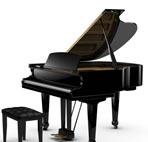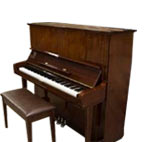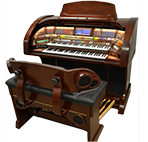It is well known that one of the most important aspects of a pianist’s work is sight reading, and “He who is the best reader gets the job” is not a bad proverb — ancient or not — for a professional pianist to pin to his wall. Sight reading should perhaps be thought of in conjunction with quick learning because, more often than not, the pianist will be given an accompaniment to perform at an audition or competition about 20 minutes before the event — and, even then, the quick learning may well have to be done during the only rehearsal!
Keyboard players get more notes to play per bar than any other kind of instrumentalist and they are expected to be good at fitting with others in ensemble, to be supportive and unassuming, and to make the “soloist” sound good. If they do all these things well they are rewarded by not being noticed. If they do them badly they are immediately identified as the person who has “sabotaged” the performance. (Even auditioners and adjudicators are frequently unaware of just how much shaping and sense of style is coming from the pianist when a performance is going well.) Unsurprisingly many of us quail before the pressure and decide to choose another career before it is too late.
All too often pianists believe they are “just hopeless at sight reading.” This is not surprising given the pressure and exposure associated with it and the fact that it may well have been treated as a poor cousin when placed alongside all the technical and interpretative matters the teacher will have worked on in the lessons. Typically a teacher will suggests the pupil finds a book for sight reading practice a few weeks before an exam.
No one is hopeless at sight reading. Rather, most people find some aspects of it challenging and, once these are pin-pointed, progress can be made. Typical problem areas are: cluster chords with a lot of accidentals, other complex-looking chords such as diminished 7ths or half diminished chords (with or without accidentals), moving parts in both hands, leaps, keys with many sharps or flats, double sharps or flats, poly-rhythms (e.g. two notes in one hand while the other is playing three). The trick is to take one of these at a time and work at it until it is no longer a problem.
Sight reading is really a matter of recognizing what you already know.
Once players understand that they are really only playing bits from pieces they already know, but put together in a different order (and in perhaps another key) confidence can be built — and confidence is one of the most important elements needed. To this end it is important that students understand what they are playing in each piece they learn and learn to recognize it on the page. I recall a wonderful teacher from the Royal College of Music (who enjoyed a reputation for being eccentric) insisting on his pupils reading their scales from the copy. Most pupils memorise their scales, or even learn them by ear in the first instance (an excellent idea in itself) and never again see them written down until they have to sight read them in the context of a piece of music. Small wonder they then find them hard to recognize!
So my main principle is that you should understand everything you play and learn to recognize it and its elements instantly on the page. When you learn a new pattern in a piece, transpose it into other keys. Learn all your scales, arpeggios and broken chords thoroughly because they are the elements from which a huge proportion of keyboard literature is made up. Learn to play segments of scales starting on notes other than the tonic, learn arpeggios in all inversions, study not only major, minor, dominant 7th and diminished 7th chords but major 7ths, minor 7ths and half-diminished as well. Learn the fingerings for whole tone scales and pentatonic scales — and learn to play all these WITHOUT LOOKING AT YOUR HANDS. When you find a new chord in a piece play it chromatically up and down the piano, then at whole tone intervals and at other intervals as well if you feel your fingers still haven’t learned the shape. You will almost certainly meet it again and your sight reading will be brilliant if everything you meet is an old friend.
By understanding what you play I mean largely that you should develop your ability to analyse the harmony, so that you can see through the complexity of dots and understand that every note may be part of a dominant 9th or whatever. It is not as important — when sight reading an accompaniment for example — to play every note as written, as it is to understand the harmonic progressions the piece is based on and improvise as necessary in order to keep with the other instruments. Whatever the style or the period — if the composer is using harmony or an “harmonic field” you should still understand which notes, scale, mode or tone row it is derived from and be prepared to improvise on that if the music is too fast or complex to play accurately the first time through. Reading without understanding the harmony is rather like an infant’s reading individual letters before he or she understands how they are made up into words. Once we recognize what the words look like we don’t need to register all the letters, we just see shapes. You may have seen the following paragraph, which was popular on the Internet a few years ago.
“Aoccdrnig to rscheearch at an Elingsh uinervtisy, it deosn’t mttaer in waht oredr the ltteers in a wrod are, the olny iprmoetnt tihng is taht the frist and lsat ltteer is at the rghit pclae. The rset can be a toatl mses and you can sitll raed it wouthit a porbelm. Tihs is bcuseae we do not raed ervey lteter by itslef but the wrod as a wlohe.”
If you would like to read more about this, try The Science of Word Recognition by Kevin Larson, July 2004. You will see that there are differing opinions on exactly how we recognize words, but general agreement that we do tend to process words as a whole rather than working them out from individual letters.
There are a number of well known aids for improving sight reading. There is the tea towel (or, better still, the apron — as used by Nadia Boulanger) placed over the hands to prevent looking — still commonly used as an aid to touch typing (another form of sight reading). There is learning to look ahead — and it can be very useful to have someone cover up the bar you are playing so that you have to do just that. Sadly, unless you have a willing friend, this could become very expensive if you are going to do anything like enough of it! You can of course, rather painstakingly, do it yourself by moving a card along as you go. There are also flash cards which are especially useful for young children and can be incorporated into games (e.g. turn up a card, run to the piano and play what you have seen from memory (it could be just one note or a rhythm) it and, if successful, win a point and/or another turn). Accompanying others at sight is also an extremely good way of developing your reading because you “have to keep going.” Informal sight reading ensemble concerts can be fun, and not necessarily a trial for the audience if the music is well chosen.
Sight reading, at whatever stage you find yourself, should be fluent, because fluency is one of the most important aspects of it. Yours eyes should scan the pages fluently and rhythmically and the music should progress without stops and starts. It is better to start with a piece which looks much too easy for you than to choose one you feel you can “just manage.” I reckon that the Associated Board sight reading tests are about three grades below the performing standard required — so, if you are sitting a Grade Five exam, you should be able to read Grade Two pieces. The Associated Board’s gradual inclusion of keys as you progress through the grades is a useful guide when choosing pieces to read.










